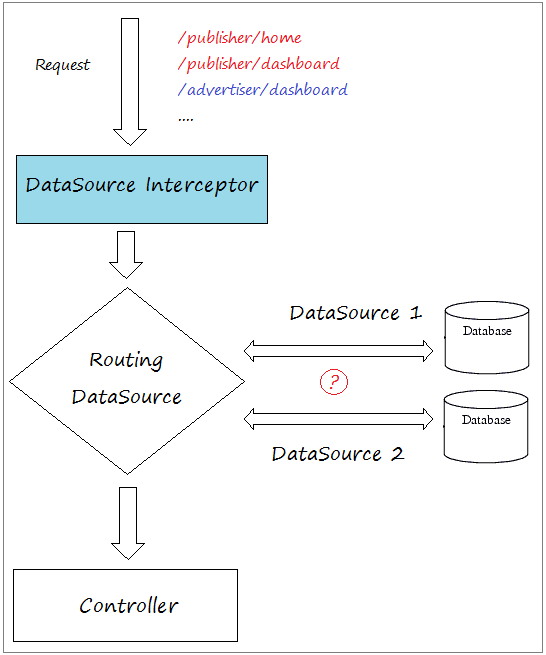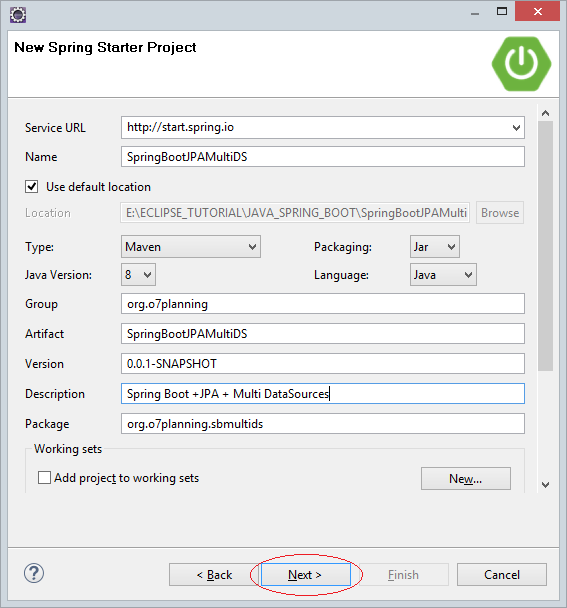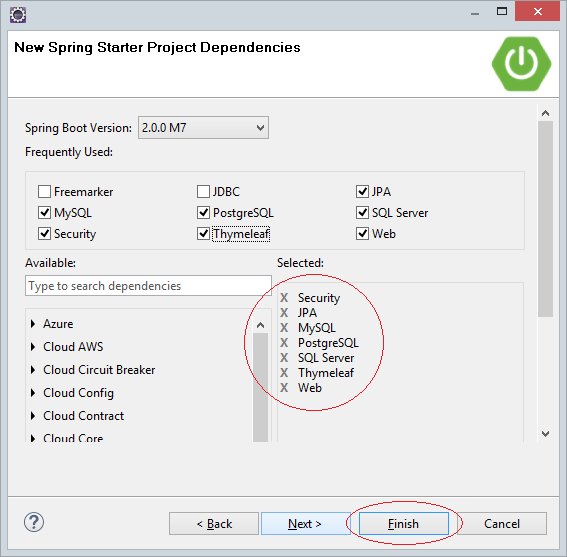Используйте несколько DataSources с Spring Boot и JPA
1. Цель статьи
Статья основана на:
Spring Boot 2.x (or >=1.5.9)
JPA
Thymeleaf (Or JSP)
В данной статье я покажу вам как создать приложение Spring Boot & JPA используя разные DataSource. Чтобы практиковать с примером у нас есть 2 базы данных:
- PUBLISHER: Это база данных 1, которая имеет таблицу PUBLISHERS.
- ADVERTISER: Это база данных 2, которая имеет таблицу ADVERTISERS.
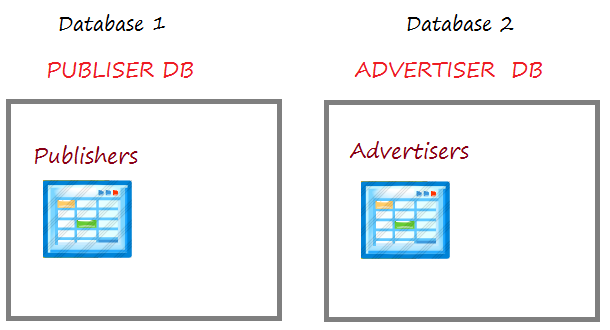
В данном приложении функции (Страницы) могут использовать одновременно оба вышеупомянутых базы данных. Например одна страница отображает список издателей (Publisher), в то же время отображает рекламодателей (Advertiser), таким образом, вам нужно работать одновременно с 2 базами данных упомянутые выше.
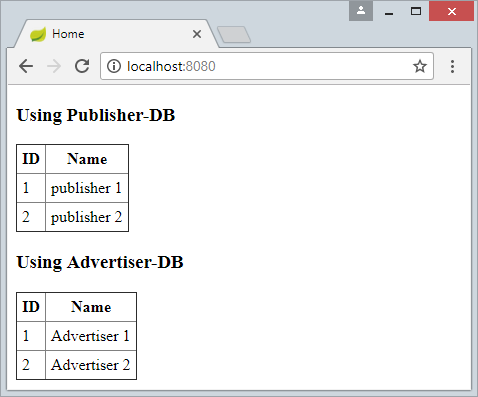
В другом случае, если вашему приложению нужно несколько DataSource, но каждая функция (каждая страница) работает только с одним определенным DataSource, вам стоит использовать Routing DataSource & DataSource Interceptor.
- Routing DataSource является особым DataSource, он содержит список реальных DataSource, которые будут использоваться в вашем приложении.
- DataSource Interceptor решает какой DataSource будет использован соответственно с каждой функцией (каждой страницей) в вашем приложении.
2. Приготовить Database
MySQL, SQL Server, PostGres
-- ===========================================
-- DATABASE FOR PUBLISHER SYSTEM
-- ===========================================
create table PUBLISHERS
(
ID Bigint,
NAME VARCHAR(255),
Primary key (ID)
);
insert into publishers (ID, NAME)
values (1, 'publisher 1');
insert into publishers (ID, NAME)
values (2, 'publisher 2');
-- ===========================================
-- DATABASE FOR ADVERTISER SYSTEM
-- ===========================================
create table ADVERTISERS
(
ID Bigint,
NAME VARCHAR(255),
Primary key (ID)
);
insert into advertisers (ID, NAME)
values (1, 'Advertiser 1');
insert into advertisers (ID, NAME)
values (2, 'Advertiser 2');Oracle
-- ===========================================
-- DATABASE FOR PUBLISHER SYSTEM
-- ===========================================
create table PUBLISHERS
(
ID NUMBER(19),
NAME VARCHAR(255),
Primary key (ID)
);
insert into publishers (ID, NAME)
values (1, 'publisher 1');
insert into publishers (ID, NAME)
values (2, 'publisher 2');
Commit;
-- ===========================================
-- DATABASE FOR ADVERTISER SYSTEM
-- ===========================================
create table ADVERTISERS
(
ID NUMBER(19),
NAME VARCHAR(255),
Primary key (ID)
);
insert into advertisers (ID, NAME)
values (1, 'Advertiser 1');
insert into advertisers (ID, NAME)
values (2, 'Advertiser 2');
Commit;4. Конфигурация pom.xml
В файле pom.xml ниже, я уже конфигурировал чтобы приложение могло работать с 4 видами распространненных баз данных это MySQL, SQL Server, PostGres, Oracle.
pom.xml
<?xml version="1.0" encoding="UTF-8"?>
<project xmlns="http://maven.apache.org/POM/4.0.0"
xmlns:xsi="http://www.w3.org/2001/XMLSchema-instance"
xsi:schemaLocation="http://maven.apache.org/POM/4.0.0
http://maven.apache.org/xsd/maven-4.0.0.xsd">
<modelVersion>4.0.0</modelVersion>
<groupId>org.o7planning</groupId>
<artifactId>SpringBootJPAMultiDS</artifactId>
<version>0.0.1-SNAPSHOT</version>
<packaging>jar</packaging>
<name>SpringBootJPAMultiDS</name>
<description>Spring Boot + JPA + Multiple DataSources</description>
<parent>
<groupId>org.springframework.boot</groupId>
<artifactId>spring-boot-starter-parent</artifactId>
<version>2.0.0.RELEASE</version>
<relativePath/> <!-- lookup parent from repository -->
</parent>
<properties>
<project.build.sourceEncoding>UTF-8</project.build.sourceEncoding>
<project.reporting.outputEncoding>UTF-8</project.reporting.outputEncoding>
<java.version>1.8</java.version>
</properties>
<dependencies>
<dependency>
<groupId>org.springframework.boot</groupId>
<artifactId>spring-boot-starter-data-jpa</artifactId>
</dependency>
<!-- Remove Thymeleaf, If you want using JSP View -->
<dependency>
<groupId>org.springframework.boot</groupId>
<artifactId>spring-boot-starter-thymeleaf</artifactId>
</dependency>
<dependency>
<groupId>org.springframework.boot</groupId>
<artifactId>spring-boot-starter-web</artifactId>
</dependency>
<dependency>
<groupId>mysql</groupId>
<artifactId>mysql-connector-java</artifactId>
<scope>runtime</scope>
</dependency>
<dependency>
<groupId>org.postgresql</groupId>
<artifactId>postgresql</artifactId>
<scope>runtime</scope>
</dependency>
<!-- SQL Server - Mssql-Jdbc driver -->
<dependency>
<groupId>com.microsoft.sqlserver</groupId>
<artifactId>mssql-jdbc</artifactId>
<scope>runtime</scope>
</dependency>
<!-- SQL Server - JTDS driver -->
<dependency>
<groupId>net.sourceforge.jtds</groupId>
<artifactId>jtds</artifactId>
<scope>runtime</scope>
</dependency>
<dependency>
<groupId>com.oracle</groupId>
<artifactId>ojdbc6</artifactId>
<version>11.2.0.3</version>
</dependency>
<!-- For JSP VIEW (Need REMOVE spring-boot-starter-thymeleaf) -->
<dependency>
<groupId>org.apache.tomcat.embed</groupId>
<artifactId>tomcat-embed-jasper</artifactId>
</dependency>
<!-- For JSP VIEW (Need REMOVE spring-boot-starter-thymeleaf) -->
<dependency>
<groupId>javax.servlet</groupId>
<artifactId>jstl</artifactId>
</dependency>
<dependency>
<groupId>org.springframework.boot</groupId>
<artifactId>spring-boot-starter-test</artifactId>
<scope>test</scope>
</dependency>
</dependencies>
<repositories>
<!-- Repository for ORACLE JDBC Driver -->
<repository>
<id>codelds</id>
<url>https://code.lds.org/nexus/content/groups/main-repo</url>
</repository>
</repositories>
<build>
<plugins>
<plugin>
<groupId>org.springframework.boot</groupId>
<artifactId>spring-boot-maven-plugin</artifactId>
</plugin>
</plugins>
</build>
</project>5. Конфигурировать DataSource
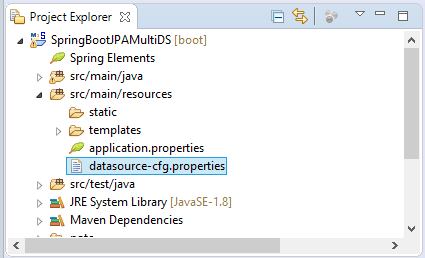
datasource-cfg.properties (MySQL)
# ===============================
# DATASOURCE
# ===============================
# DataSource (PUBLISHER System).
spring.datasource.driver-class-name.1=com.mysql.jdbc.Driver
spring.datasource.url.1=jdbc:mysql://localhost:3306/publisher
spring.datasource.username.1=root
spring.datasource.password.1=12345
# DataSource (ADVERTISER System).
spring.datasource.driver-class-name.2=com.mysql.jdbc.Driver
spring.datasource.url.2=jdbc:mysql://localhost:3306/advertiser
spring.datasource.username.2=root
spring.datasource.password.2=12345
# ===============================
# JPA / HIBERNATE
# ===============================
spring.jpa.show-sql.1=true
spring.jpa.hibernate.ddl-auto.1=none
spring.jpa.properties.hibernate.dialect.1=org.hibernate.dialect.MySQLDialect
#spring.jpa.properties.hibernate.current_session_context_class.1=org.springframework.orm.hibernate5.SpringSessionContext
spring.jpa.show-sql.2=true
spring.jpa.hibernate.ddl-auto.2=none
spring.jpa.properties.hibernate.dialect.2=org.hibernate.dialect.MySQLDialect
#spring.jpa.properties.hibernate.current_session_context_class.2=org.springframework.orm.hibernate5.SpringSessionContextdatasource-cfg.properties (SQL Server + JTDS Driver)
# ===============================
# DATASOURCE
# ===============================
# DataSource (PUBLISHER System).
spring.datasource.driver-class-name.1=net.sourceforge.jtds.jdbc.Driver
spring.datasource.url.1=jdbc:jtds:sqlserver://localhost:1433/publisher;instance=SQLEXPRESS
spring.datasource.username.1=sa
spring.datasource.password.1=12345
# DataSource (ADVERTISER System).
spring.datasource.driver-class-name.2=net.sourceforge.jtds.jdbc.Driver
spring.datasource.url.2=jdbc:jtds:sqlserver://localhost:1433/advertiser;instance=SQLEXPRESS
spring.datasource.username.2=sa
spring.datasource.password.2=12345
# ===============================
# JPA / HIBERNATE
# ===============================
spring.jpa.show-sql.1=true
spring.jpa.hibernate.ddl-auto.1=none
spring.jpa.properties.hibernate.dialect.1=org.hibernate.dialect.SQLServerDialect
#spring.jpa.properties.hibernate.current_session_context_class.1=org.springframework.orm.hibernate5.SpringSessionContext
spring.jpa.show-sql.2=true
spring.jpa.hibernate.ddl-auto.2=none
spring.jpa.properties.hibernate.dialect.2=org.hibernate.dialect.SQLServerDialect
#spring.jpa.properties.hibernate.current_session_context_class.2=org.springframework.orm.hibernate5.SpringSessionContextdatasource-cfg.properties (SQL Server + Mssql-Jdbc Driver)
# ===============================
# DATASOURCE
# ===============================
# DataSource (PUBLISHER System).
spring.datasource.driver-class-name.1=com.microsoft.sqlserver.jdbc.SQLServerDriver
spring.datasource.url.1=jdbc:sqlserver://tran-vmware-pc\\SQLEXPRESS:1433;databaseName=publisher
spring.datasource.username.1=sa
spring.datasource.password.1=12345
# DataSource (ADVERTISER System).
spring.datasource.driver-class-name.2=com.microsoft.sqlserver.jdbc.SQLServerDriver
spring.datasource.url.2=jdbc:sqlserver://tran-vmware-pc\\SQLEXPRESS:1433;databaseName=advertiser
spring.datasource.username.2=sa
spring.datasource.password.2=12345
# ===============================
# JPA / HIBERNATE
# ===============================
spring.jpa.show-sql.1=true
spring.jpa.hibernate.ddl-auto.1=none
spring.jpa.properties.hibernate.dialect.1=org.hibernate.dialect.SQLServerDialect
#spring.jpa.properties.hibernate.current_session_context_class.1=org.springframework.orm.hibernate5.SpringSessionContext
spring.jpa.show-sql.2=true
spring.jpa.hibernate.ddl-auto.2=none
spring.jpa.properties.hibernate.dialect.2=org.hibernate.dialect.SQLServerDialect
#spring.jpa.properties.hibernate.current_session_context_class.2=org.springframework.orm.hibernate5.SpringSessionContextdatasource-cfg.properties (Oracle)
# ===============================
# DATASOURCE
# ===============================
# DataSource (PUBLISHER System).
spring.datasource.driver-class-name.1=oracle.jdbc.driver.OracleDriver
spring.datasource.url.1=jdbc:oracle:thin:@localhost:1521:db12c
spring.datasource.username.1=publisher
spring.datasource.password.1=12345
# DataSource (ADVERTISER System).
spring.datasource.driver-class-name.2=oracle.jdbc.driver.OracleDriver
spring.datasource.url.2=jdbc:oracle:thin:@localhost:1521:db12c
spring.datasource.username.2=advertiser
spring.datasource.password.2=12345
# ===============================
# JPA / HIBERNATE
# ===============================
spring.jpa.show-sql.1=true
spring.jpa.hibernate.ddl-auto.1=none
spring.jpa.properties.hibernate.dialect.1=org.hibernate.dialect.Oracle10gDialect
#spring.jpa.properties.hibernate.current_session_context_class.1=org.springframework.orm.hibernate5.SpringSessionContext
spring.jpa.show-sql.2=true
spring.jpa.hibernate.ddl-auto.2=none
spring.jpa.properties.hibernate.dialect.2=org.hibernate.dialect.Oracle10gDialect
#spring.jpa.properties.hibernate.current_session_context_class.2=org.springframework.orm.hibernate5.SpringSessionContedatasource-cfg.properties (PostGres)
# ===============================
# DATASOURCE
# ===============================
# DataSource (PUBLISHER System).
spring.datasource.driver-class-name.1=org.postgresql.Driver
spring.datasource.url.1=jdbc:postgresql://tran-vmware-pc:5432/publisher
spring.datasource.username.1=postgres
spring.datasource.password.1=12345
# DataSource (ADVERTISER System).
spring.datasource.driver-class-name.2=org.postgresql.Driver
spring.datasource.url.2=jdbc:postgresql://tran-vmware-pc:5432/advertiser
spring.datasource.username.2=postgres
spring.datasource.password.2=12345
# ===============================
# JPA / HIBERNATE
# ===============================
spring.jpa.show-sql.1=true
spring.jpa.hibernate.ddl-auto.1=none
spring.jpa.properties.hibernate.dialect.1=org.hibernate.dialect.PostgreSQL9Dialect
#spring.jpa.properties.hibernate.current_session_context_class.1=org.springframework.orm.hibernate5.SpringSessionContext
spring.jpa.show-sql.2=true
spring.jpa.hibernate.ddl-auto.2=none
spring.jpa.properties.hibernate.dialect.2=org.hibernate.dialect.PostgreSQL9Dialect
#spring.jpa.properties.hibernate.current_session_context_class.2=org.springframework.orm.hibernate5.SpringSessionContextПо умолчанию Spring Boot автоматически конфигурирует DataSource по умолчанию, поэтому вам нужно отключить данную автоматическую конфигурацию у Spring Boot, и конфигурировать ваш отдельный DataSource вручную.
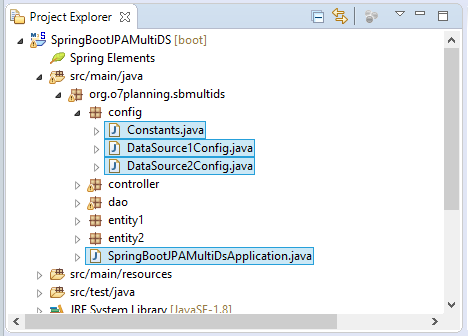
SpringBootJPAMultiDsApplication.java
package org.o7planning.sbmultids;
import org.springframework.boot.SpringApplication;
import org.springframework.boot.autoconfigure.EnableAutoConfiguration;
import org.springframework.boot.autoconfigure.SpringBootApplication;
import org.springframework.boot.autoconfigure.jdbc.DataSourceAutoConfiguration;
import org.springframework.boot.autoconfigure.jdbc.DataSourceTransactionManagerAutoConfiguration;
import org.springframework.boot.autoconfigure.orm.jpa.HibernateJpaAutoConfiguration;
@SpringBootApplication
// Disable some Spring Boot auto config
@EnableAutoConfiguration(exclude = { //
DataSourceAutoConfiguration.class, //
DataSourceTransactionManagerAutoConfiguration.class, //
HibernateJpaAutoConfiguration.class })
public class SpringBootJPAMultiDsApplication {
public static void main(String[] args) {
SpringApplication.run(SpringBootJPAMultiDsApplication.class, args);
}
}Далее мы конфигурируем 2 DataSource:
- Класс DataSource1Config используется чтобы конфигурировать datasource 1 (PUBLISHER DB).
- Класс DataSource2Config используется чтобы конфигурировать datasource datasource 2 (ADVERTISER DB).
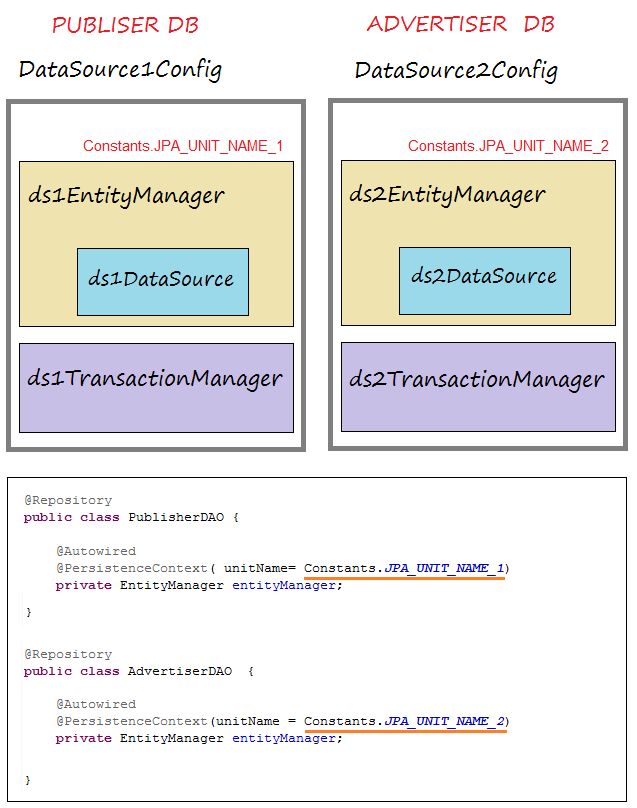
Constants.java
package org.o7planning.sbmultids.config;
public class Constants {
public static final String PACKAGE_ENTITIES_1 = "org.o7planning.sbmultids.entity1";
public static final String PACKAGE_ENTITIES_2 = "org.o7planning.sbmultids.entity2";
public static final String JPA_UNIT_NAME_1 ="PERSITENCE_UNIT_NAME_1";
public static final String JPA_UNIT_NAME_2 ="PERSITENCE_UNIT_NAME_2";
}DataSource1Config.java
package org.o7planning.sbmultids.config;
import java.util.HashMap;
import javax.sql.DataSource;
import org.springframework.beans.factory.annotation.Autowired;
import org.springframework.context.annotation.Bean;
import org.springframework.context.annotation.Configuration;
import org.springframework.context.annotation.PropertySource;
import org.springframework.context.annotation.PropertySources;
import org.springframework.core.env.Environment;
import org.springframework.jdbc.datasource.DriverManagerDataSource;
import org.springframework.orm.jpa.JpaTransactionManager;
import org.springframework.orm.jpa.LocalContainerEntityManagerFactoryBean;
import org.springframework.orm.jpa.vendor.HibernateJpaVendorAdapter;
import org.springframework.transaction.PlatformTransactionManager;
@Configuration
// Load to Environment
// (@see resources/datasource-cfg.properties).
@PropertySources({ @PropertySource("classpath:datasource-cfg.properties") })
public class DataSource1Config {
@Autowired
private Environment env; // Contains Properties Load by @PropertySources
@Bean
public DataSource ds1Datasource() {
DriverManagerDataSource dataSource = new DriverManagerDataSource();
dataSource.setDriverClassName(env.getProperty("spring.datasource.driver-class-name.1"));
dataSource.setUrl(env.getProperty("spring.datasource.url.1"));
dataSource.setUsername(env.getProperty("spring.datasource.username.1"));
dataSource.setPassword(env.getProperty("spring.datasource.password.1"));
return dataSource;
}
@Bean
public LocalContainerEntityManagerFactoryBean ds1EntityManager() {
LocalContainerEntityManagerFactoryBean em = new LocalContainerEntityManagerFactoryBean();
em.setDataSource(ds1Datasource());
// Scan Entities in Package:
em.setPackagesToScan(new String[] { Constants.PACKAGE_ENTITIES_1 });
em.setPersistenceUnitName(Constants.JPA_UNIT_NAME_1); // Important !!
//
HibernateJpaVendorAdapter vendorAdapter = new HibernateJpaVendorAdapter();
em.setJpaVendorAdapter(vendorAdapter);
HashMap<String, Object> properties = new HashMap<>();
// JPA & Hibernate
properties.put("hibernate.dialect", env.getProperty("spring.jpa.properties.hibernate.dialect.1"));
properties.put("hibernate.show-sql", env.getProperty("spring.jpa.show-sql.1"));
// Solved Error: PostGres createClob() is not yet implemented.
// PostGres Only:
// properties.put("hibernate.temp.use_jdbc_metadata_defaults", false);
em.setJpaPropertyMap(properties);
em.afterPropertiesSet();
return em;
}
@Bean
public PlatformTransactionManager ds1TransactionManager() {
JpaTransactionManager transactionManager = new JpaTransactionManager();
transactionManager.setEntityManagerFactory(ds1EntityManager().getObject());
return transactionManager;
}
}DataSource2Config.java
package org.o7planning.sbmultids.config;
import java.util.HashMap;
import javax.sql.DataSource;
import org.springframework.beans.factory.annotation.Autowired;
import org.springframework.context.annotation.Bean;
import org.springframework.context.annotation.Configuration;
import org.springframework.context.annotation.PropertySource;
import org.springframework.context.annotation.PropertySources;
import org.springframework.core.env.Environment;
import org.springframework.jdbc.datasource.DriverManagerDataSource;
import org.springframework.orm.jpa.JpaTransactionManager;
import org.springframework.orm.jpa.LocalContainerEntityManagerFactoryBean;
import org.springframework.orm.jpa.vendor.HibernateJpaVendorAdapter;
import org.springframework.transaction.PlatformTransactionManager;
@Configuration
// Load to Environment
// (@see resources/datasource-cfg.properties).
@PropertySources({ @PropertySource("classpath:datasource-cfg.properties") })
public class DataSource2Config {
@Autowired
private Environment env; // Contains Properties Load by @PropertySources
@Bean
public DataSource ds2Datasource() {
DriverManagerDataSource dataSource = new DriverManagerDataSource();
dataSource.setDriverClassName(env.getProperty("spring.datasource.driver-class-name.2"));
dataSource.setUrl(env.getProperty("spring.datasource.url.2"));
dataSource.setUsername(env.getProperty("spring.datasource.username.2"));
dataSource.setPassword(env.getProperty("spring.datasource.password.2"));
return dataSource;
}
@Bean
public LocalContainerEntityManagerFactoryBean ds2EntityManager() {
LocalContainerEntityManagerFactoryBean em = new LocalContainerEntityManagerFactoryBean();
em.setDataSource(ds2Datasource());
// Scan Entities in Package:
em.setPackagesToScan(new String[] { Constants.PACKAGE_ENTITIES_2 });
em.setPersistenceUnitName(Constants.JPA_UNIT_NAME_2);
HibernateJpaVendorAdapter vendorAdapter = new HibernateJpaVendorAdapter();
em.setJpaVendorAdapter(vendorAdapter);
HashMap<String, Object> properties = new HashMap<>();
// JPA & Hibernate
properties.put("hibernate.dialect", env.getProperty("spring.jpa.properties.hibernate.dialect.2"));
properties.put("hibernate.show-sql", env.getProperty("spring.jpa.show-sql.2"));
// Solved Error: PostGres createClob() is not yet implemented.
// PostGres Only.
// properties.put("hibernate.temp.use_jdbc_metadata_defaults", false);
em.setJpaPropertyMap(properties);
em.afterPropertiesSet();
return em;
}
@Bean
public PlatformTransactionManager ds2TransactionManager() {
JpaTransactionManager transactionManager = new JpaTransactionManager();
transactionManager.setEntityManagerFactory(ds2EntityManager().getObject());
return transactionManager;
}
}6. Entities, DAO
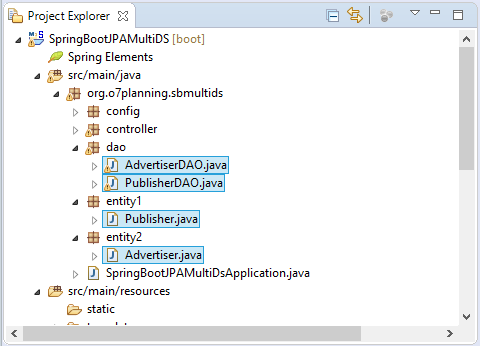
Publisher.java
package org.o7planning.sbmultids.entity1;
import java.io.Serializable;
import javax.persistence.Column;
import javax.persistence.Entity;
import javax.persistence.GeneratedValue;
import javax.persistence.Id;
import javax.persistence.Table;
@Entity
@Table(name = "Publishers")
public class Publisher implements Serializable {
private static final long serialVersionUID = 746237126088051312L;
@Id
@GeneratedValue
@Column(name = "Id")
private Long id;
@Column(name = "Name", length = 255, nullable = false)
private String name;
public Long getId() {
return id;
}
public void setId(Long id) {
this.id = id;
}
public String getName() {
return name;
}
public void setName(String name) {
this.name = name;
}
}Advertiser.java
package org.o7planning.sbmultids.entity2;
import java.io.Serializable;
import javax.persistence.Column;
import javax.persistence.Entity;
import javax.persistence.GeneratedValue;
import javax.persistence.Id;
import javax.persistence.Table;
@Entity
@Table(name = "Advertisers")
public class Advertiser implements Serializable {
private static final long serialVersionUID = 746237126088051312L;
@Id
@GeneratedValue
@Column(name = "Id")
private Long id;
@Column(name = "Name", length = 255, nullable = false)
private String name;
public Long getId() {
return id;
}
public void setId(Long id) {
this.id = id;
}
public String getName() {
return name;
}
public void setName(String name) {
this.name = name;
}
}PublisherDAO.java
package org.o7planning.sbmultids.dao;
import java.util.List;
import javax.persistence.EntityManager;
import javax.persistence.PersistenceContext;
import javax.persistence.Query;
import org.o7planning.sbmultids.config.Constants;
import org.o7planning.sbmultids.entity1.Publisher;
import org.springframework.beans.factory.annotation.Autowired;
import org.springframework.stereotype.Repository;
@Repository
public class PublisherDAO {
@Autowired
@PersistenceContext( unitName= Constants.JPA_UNIT_NAME_1)
private EntityManager entityManager;
public List<Publisher> listPublishers() {
String sql = "Select e from " + Publisher.class.getName() + " e ";
Query query = entityManager.createQuery(sql, Publisher.class);
return query.getResultList();
}
public Publisher findById(Long id) {
return this.entityManager.find(Publisher.class, id);
}
}AdvertiserDAO.java
package org.o7planning.sbmultids.dao;
import java.util.List;
import javax.persistence.EntityManager;
import javax.persistence.PersistenceContext;
import javax.persistence.Query;
import org.o7planning.sbmultids.config.Constants;
import org.o7planning.sbmultids.entity2.Advertiser;
import org.springframework.beans.factory.annotation.Autowired;
import org.springframework.stereotype.Repository;
@Repository
public class AdvertiserDAO {
@Autowired
@PersistenceContext(unitName = Constants.JPA_UNIT_NAME_2)
private EntityManager entityManager;
public List<Advertiser> listAdvertisers() {
String sql = "Select e from " + Advertiser.class.getName() + " e ";
Query query = entityManager.createQuery(sql, Advertiser.class);
return query.getResultList();
}
public Advertiser findById(Long id) {
return this.entityManager.find(Advertiser.class, id);
}
}7. Controller
MainController.java
package org.o7planning.sbmultids.controller;
import java.util.List;
import org.o7planning.sbmultids.dao.AdvertiserDAO;
import org.o7planning.sbmultids.dao.PublisherDAO;
import org.o7planning.sbmultids.entity1.Publisher;
import org.o7planning.sbmultids.entity2.Advertiser;
import org.springframework.beans.factory.annotation.Autowired;
import org.springframework.stereotype.Controller;
import org.springframework.ui.Model;
import org.springframework.web.bind.annotation.RequestMapping;
import org.springframework.web.bind.annotation.RequestMethod;
@Controller
public class MainController {
@Autowired
private PublisherDAO publisherDAO;
@Autowired
private AdvertiserDAO advertiserDAO;
@RequestMapping(value = "/", method = RequestMethod.GET)
public String homePage(Model model) {
List<Advertiser> advertisers = advertiserDAO.listAdvertisers();
List<Publisher> publishers = publisherDAO.listPublishers();
model.addAttribute("advertisers", advertisers);
model.addAttribute("publishers", publishers);
return "home";
}
}8. Thymeleaf Template
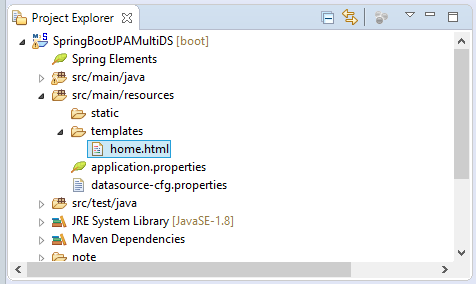
home.html
<!DOCTYPE html>
<html xmlns:th="http://www.thymeleaf.org">
<head>
<meta charset="UTF-8"/>
<title>Home</title>
<style>
th, td {
padding: 5px;
}
table {
border-collapse: collapse;
}
</style>
</head>
<body>
<h3>Using Publisher-DB</h3>
<table border="1">
<tr>
<th>ID</th>
<th>Name</th>
</tr>
<tr th:each="publisher : ${publishers}">
<td th:utext="${publisher.id}"></td>
<td th:utext="${publisher.name}"></td>
</tr>
</table>
<h3>Using Advertiser-DB</h3>
<table border="1">
<tr>
<th>ID</th>
<th>Name</th>
</tr>
<tr th:each="advertiser : ${advertisers}">
<td th:utext="${advertiser.id}"></td>
<td th:utext="${advertiser.name}"></td>
</tr>
</table>
</body>
</html>9. Аппендикс: JSP View
No ADS
Смотрите так же:
В случае, если вы используете технологию JSP для уровня View:
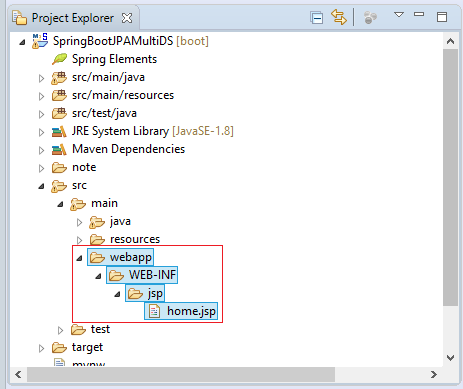
home.jsp
<%@ taglib uri="http://java.sun.com/jsp/jstl/core" prefix="c"%>
<%@ page contentType="text/html; charset=UTF-8" %>
<!DOCTYPE html>
<html xmlns:th="http://www.thymeleaf.org">
<head>
<meta charset="UTF-8"/>
<title>Home</title>
<style>
th, td {
padding: 5px;
}
table {
border-collapse: collapse;
}
</style>
</head>
<body>
<h3>Using Publisher-DB</h3>
<table border="1">
<tr>
<th>ID</th>
<th>Name</th>
</tr>
<c:forEach items="${publishers}" var="publisher">
<tr>
<td th:utext="${publisher.id}"></td>
<td th:utext="${publisher.name}"></td>
</tr>
</c:forEach>
</table>
<h3>Using Advertiser-DB</h3>
<table border="1">
<tr>
<th>ID</th>
<th>Name</th>
</tr>
<c:forEach items="${advertisers}" var="advertiser">
<tr>
<td th:utext="${advertiser.id}"></td>
<td th:utext="${advertiser.name}"></td>
</tr>
</c:forEach>
</table>
</body>
</html>No ADS
Руководства Spring Boot
- Установите Spring Tool Suite для Eclipse
- Руководство Spring для начинающих
- Руководство Spring Boot для начинающих
- Общие свойства Spring Boot
- Руководство Spring Boot и Thymeleaf
- Руководство Spring Boot и FreeMarker
- Руководство Spring Boot и Groovy
- Руководство Spring Boot и Mustache
- Руководство Spring Boot и JSP
- Руководство Spring Boot, Apache Tiles, JSP
- Используйте Logging в Spring Boot
- Мониторинг приложений с помощью Spring Boot Actuator
- Создание веб-приложения с несколькими языками с помощью Spring Boot
- Используйте несколько ViewResolver в Spring Boot
- Используйте Twitter Bootstrap в Spring Boot
- Руководство Spring Boot Interceptor
- Руководство Spring Boot, Spring JDBC и Spring Transaction
- Руководство Spring JDBC
- Руководство Spring Boot, JPA и Spring Transaction
- Руководство Spring Boot и Spring Data JPA
- Руководство Spring Boot, Hibernate и Spring Transaction
- Интеграция Spring Boot, JPA и H2 Database
- Руководство Spring Boot и MongoDB
- Используйте несколько DataSources с Spring Boot и JPA
- Используйте несколько DataSource с Spring Boot и RoutingDataSource
- Создайте приложение для входа с Spring Boot, Spring Security, Spring JDBC
- Создайте приложение для входа с Spring Boot, Spring Security, JPA
- Создайте приложение регистрации пользователей с помощью Spring Boot, Spring Form Validation
- Пример OAuth2 Social Login в Spring Boot.
- Запускать фоновые запланированные задачи в Spring
- Пример CRUD Restful Web Service c Spring Boot
- Пример Spring Boot Restful Client c RestTemplate
- Пример CRUD с Spring Boot, REST и AngularJS
- Защита Spring Boot RESTful Service используя Basic Authentication
- Защита Spring Boot RESTful Service используя Auth0 JWT
- Пример Upload file c Spring Boot
- Пример Download file c Spring Boot
- Пример Upload file c Spring Boot и jQuery Ajax
- Пример Upload file c Spring Boot и AngularJS
- Создание веб-приложения для корзины покупок с помощью Spring Boot, Hibernate
- Руководство Spring Email
- Создайте простое приложение Chat с Spring Boot и Websocket
- Разверните приложение Spring Boot на Tomcat Server
- Развертывание приложения Spring Boot на Oracle WebLogic Server
- Установите бесплатный сертификат Let's Encrypt SSL для Spring Boot
- Настройте Spring Boot для перенаправления HTTP на HTTPS
Show More
